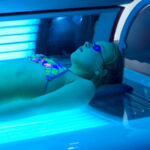Key Facts
- Indoor tanning with UV light is just as unsafe as tanning outside.
- No matter how dark your skin, indoor tanning causes skin damage and puts you at an increased risk for skin cancer.
- You are much more likely to get skin cancer if you start indoor tanning during your teen and early adult years.
- To get color safely, use a sunless tanner with SPF that is approved by the Skin Cancer Foundation.

You probably know that too much sun exposure can be harmful to your skin and may lead to wrinkles and skin cancer, but what about indoor tanning? Since you’re not getting direct exposure from the sun, it has to be safer – right? Wrong! Not only is indoor tanning unsafe, it can actually be worse for you than being out in the sun without sunscreen. The World Health Organization (WHO) has classified tanning devices as something that can cause cancer in humans. Harmful UV rays also cause wrinkles, age spots and premature aging.
Why is indoor tanning bad?
Indoor tanning includes all “artificial” (fake) light sources. Tanning beds or booths give off ultraviolet light called UV rays, which go through many layers of skin. These rays can cause severe damage; including wrinkles, eye damage, and over time can lead to skin cancer. UV rays from tanning devices are classified by the International Agency for Research on Cancer as a “group one carcinogen” – part of the same group that tobacco is in. A carcinogen is something that causes cancer. The special lights used in tanning salons give off as many as 12 times more UV rays than the sun does, so you’re getting a lot more exposure in a shorter amount of time.
Take the true/false quiz below to see how much you know about indoor tanning
What about sunless tanners?
Unlike tanning beds or booths, sunless tanners, self-tanning lotions or bronzers don’t harm your skin. Sunless tanning products come in a variety of forms, such as: lotions, sprays, gels and towelettes. These products are usually cheaper compared to the cost of tanning indoors and the color will last about 3-5 days. Look for the seal of approval from the Skin Cancer Foundation. Products with this seal have been reviewed and meet specific criteria that evaluate safety and effectiveness.
Check to see if your self-tanning product(s) meets the same standards: http://www.skincancer.org/products/categories
Is there another way to get a tan aside from UV light and self-tanners?
Spray Tanning: Spray tanning or sunless tanning can give your skin a tan-like color by using a chemical known as dihydroxyacetone or (DHA). DHA is approved by the Federal Food and Drug Administration (FDA) for EXTERNAL use only. DHA interacts with dead surface cells in the first layer of your skin (epidermis) and darkens the color of your skin, resulting in a fake tan. Typically, the “tan” lasts 5 to 7 days. It’s important to remember that most sunless tanners do not contain SPF, so you’ll need to apply sunscreen before heading outdoors.
Whether a salon offers an automatic self-tanner done by a machine or by hand, be sure that your eyes, nose, mouth, and ears are protected. If the salon does not offer protection such as goggles, ear plugs, etc. find another salon that does. Although the chemicals are considered safe for external use DHA can be dangerous if you inhale or consume it.
Tanning Pills: There are pills sold in some stores that promote a sunless tan. These pills are NOT approved by the FDA, which means that they have not been tested and approved according to the US government standards. These pills contain a harmful chemical known as canthaxanthin which can change the color of the skin anywhere from orange to brown. Canthaxanthin can cause allergic reactions, serious eye problems, nausea, cramping, diarrhea, severe itching welts, and can damage your liver.
If you decide you must have a tan using UV light (even though you know that it comes with serious risks), make sure you follow these safety precautions:
- Check to see if the staff at the tanning salon know how to set the timer on the tanning equipment based on the manufacturer-recommended exposure times, and know about various skin types and what you need to do to protect your eyes from the UV light.
- Before tanning, make sure that the bed or booth has a safety power shut-off feature, and know where it is.
- Always wear protective eye goggles that fit securely. Make sure they aren’t cracked.
- Clean the tanning bed with a safe disinfectant before and after you use it – the tanning salon should provide the cleaner and paper towels.
- Don’t buy unlimited tanning packages, even if it seems like a good deal. Limit the number of times you tan. Remember, it takes up to 48 hours for a tan to appear on your skin.
- Make a list of any medication you are taking, and ask your health care provider if it’s okay to visit a tanning salon. Some medicines cause sensitivity to UV light. For example: Accutane® (used to treat acne), and antibiotics such as Doxycycline will make your skin more sensitive to the UV rays, causing your skin to burn faster.
Our health guides are developed through a systematic, rigorous process to ensure accuracy, reliability, and trustworthiness. Written and reviewed by experienced healthcare clinicians from Boston Children's Hospital, a Harvard Medical School teaching hospital and consistently ranked as a top hospital by Newsweek and U.S. News & World Report, these guides combine clinical expertise, specialized knowledge, and evidence-based medicine. We also incorporate research and best practices from authoritative sources such as the CDC, NIH, PubMed, top medical journals, and UpToDate.com. Clinical specialists and subject matter experts review and edit each guide, reinforcing our commitment to high-quality, factual, scientifically accurate health information for young people.

